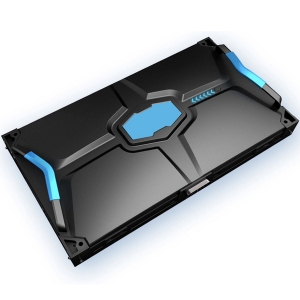What Is Refresh Rate?
Have you ever observed that when you click a picture or make a video of your screen, it might flicker, or a mosaic pattern appears on your images? Or sometimes when you are watching a show and the screens which are stages behind. He does not seem straightforward, and it means that the screen has a low refresh rate. Don’t worry, in this article we are going to discuss everything about it.
1. What Does Refresh Rate Mean?
Refresh rate is the number of times the electron beam is repeatedly scanned to the image on the screen. The higher the refresh rate, the better the stability of the displayed image (screen). The display monitor refresh rate will directly determine the price, but because the refresh rate and resolution of both constraints, so only in high resolution to achieve a high refresh rate so that the monitor can be called its excellent performance.
It can also be understood that the refresh rate is the number of times the screen is refreshed per second, when watching a movie, we actually see a pair of still images, like a slide show, why do we feel that the picture is moving, it is because the human eye has a visual stay effect, the impression of the previous picture in the brain has not disappeared, followed by the next picture to follow up, and the difference between the two pairs of images is very small, a Assuming that an action is completed by 20 pictures, we look a bit like a cartoon, and the action is increased to 30 pictures, it looks more natural, which is the display refresh rate test.
Refresh rate is divided into vertical refresh rate and horizontal refresh rate, the general mention of refresh rate usually refers to the vertical refresh rate. Vertical refresh rate indicates how many times per second the screen image redraws, that is, the number of screen refresh per second, in Hz (Hertz). The higher the refresh rate the better, the more stable the image will be, the more natural and clear the image display will be, and the less impact on the eyes.
The lower the refresh frequency, the more powerful the image flicker and jitter, the faster the eye fatigue. If you can achieve a refresh rate of 80Hz or more, you can eliminate the image flicker and jitter, and your eyes will not be too easily fatigued.
The led display refresh frequency or refresh rate is the number of times per second a screen refresh itself. The images you see on your screen result from continuous refreshments in each led. the led tv screen refresh rate is so fast that it is invisible to human eyes. Although we cannot see this rate, a screen is continuously refreshing itself. It can also be defined as “how many times it draws a new image on the screen, per second. For example, a 60Hz refresh frequency means that the screen is refreshing 60 times per second.
Its measurement unit is the same as the frequency in System International Unit, the Hertz (Hz). The refresh frequency is very important for motion handling because, in most cases, a higher refresh frequency means smoother motion. But this is not the case in every situation.
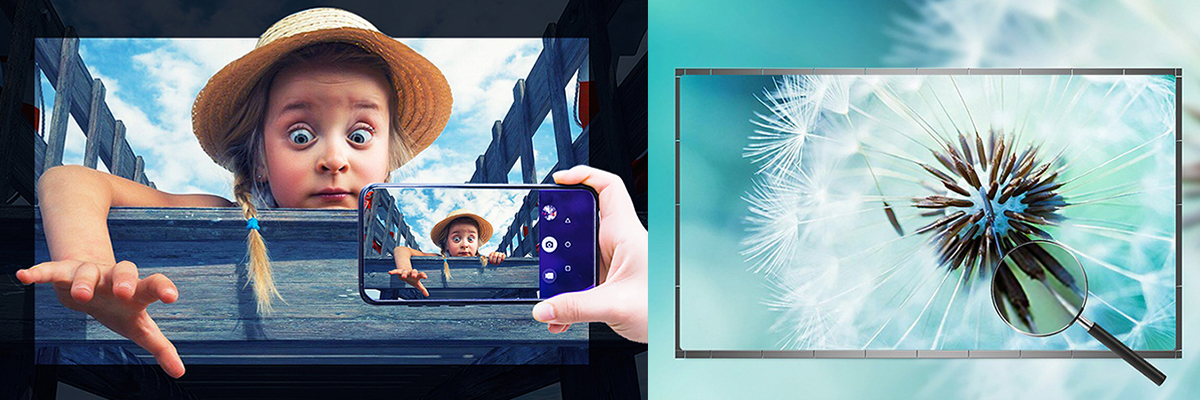
2. Difference Between Refresh Rate and Frame Rate:
Refresh frequency can be a confusing trait of a screen, and it is often mixed with a screen’s frame rate. But frame rate is generally defined as the measurement rate of a source with which it sends a new frame on screen per second (fps). A video on-screen will typically have a frame per second rate of 24 or 30 fps. The question of why we cannot see this is because everything above 15 fps is considered smooth to human eyes.
So, for the perfect motion, your source with the 60 frames per second should have a screen with a refresh rate of 60 times per second. Otherwise, the action will be blurry. Most of the time refresh rate is higher than the frame rate of a screen. So, frame refreshes will repeat the same frame multiple times to match the frame rate with refresh frequency/rate.
For example, if you have a video playing on-screen with a frame rate of 24 fps and its refresh rate is 120 Hz, the processor will refresh every frame five times on the screen to match it with the 24 frames taken up in a whole one second. To summaries it, we can say that “frame rate refers to the content itself and refresh rate refers to the video signal or display.”
The refresh frequency affected motion handling; the more display will draw an image on the screen, the better it will be for fast-moving videos. Nowadays, modern TVs have a 60Hz or 120 Hz responses rate. But higher response rate does not always mean that the motion quality will be increased.
Because it is also dependent upon the response time of the screen. A quick response time means that the motion will be excellent and clear. While the screen with a low response time means the image will be blurred. Refresh rate and response rate are indirectly related to each other. Generally, a 120 Hz screen will be expected to have a better response time than a 60 Hz screen, but this always will not be the case.
Some hardware players have introduced ditcher or frame interpolation technology. This means that “these systems generate new frames between two consecutive frames by making a comparative calculation. In this way, these systems will generate intermediate images between actual frames of video content. These interpolated frames allow producing more frames per second. In this way, the improve the fluidity and reproduction of the content in accelerated movement.
3. The Relationship Between Refresh Frequency and LED Screen:
In the process of buying led display, there are always some monikers and parameters around, such as brightness, contrast, refresh rate, current, driver chip, IP65, etc. So, what exactly is the relationship between refresh frequency and led display?
Refresh frequency, that is, the rate of led display update, usually expressed in Hertz (Hz) as a unit. The refresh rate of led display is higher than 1000Hz, the human eye basically cannot distinguish. When the refresh rate is above 3,000Hz, it is a high performance led display. The higher the refresh frequency, the more stable the screen display, the smoother the video playback will be. And in the camera or photography, the picture display will be clearer, there will be no flicker or water streaks and other phenomena exist.
LED display low “refresh frequency”, its impact in addition to the camera, photography will appear water streaks, while also occurring like tens of thousands of light bulbs flickering image, the human eye in the viewing, may produce discomfort, and even cause injury to the eyes.
The refresh frequency is derived from the different choices of driver chips. When using a common driver chip, the refresh rate for full color is 960Hz, and the refresh rate for single and dual color is 480Hz. when using a dual latching driver chip, the refresh rate is above 1920Hz. When using the HD high level PWM driver chip, the refresh rate is up to 3840Hz or more.
HD high-grade PWM driver chip, ≥ 3840Hz led refresh rate, screen display stable and smooth, no ripple, no lag, no sense of visual flicker, not only can enjoy the quality led screen, and effective protection of vision, want to see how long to see how long, eyes are not tired at all.

4. LED Display Refresh Frequency (Visual Refresh Frequency):
“Visual refresh frequency” refers to the rate of screen update, usually expressed in Hertz (Hz) as a unit the visual refresh frequency of 3,000Hz or more, for high performance led display. The higher the visual refresh frequency, the more stable the screen display, the smaller the sense of visual flicker.
LED display low “visual refresh frequency”, its impact in addition to video, photography, horizontal stripes, while also occurring like tens of thousands of light bulbs at the same time flickering image, the human eye in the viewing may produce discomfort, and even cause eye damage.
Although the human eye, the visual refresh rate of 60Hz or more has been felt as a continuous picture, but the higher the visual refresh rate, the more stable the image displayed, the less likely the human eye to feel fatigue.
Nowadays, in high quality video, to get a more detailed picture, such as wonderful playback or close-up photography process, have been filmed with a high-speed camera more than 1,000Hz per second. At this time, it is a great challenge for the led display, which will also be filmed, to be able to present continuous images (no black scan lines) or continuous color gradation under high-speed shutter.
Micro-pitch led display refresh rate of not less than 3840Hz, the ingestion of the screen is stable without ripple without black screen, can effectively solve the image of the rapid movement process of trailing and blurring, enhance the clarity and contrast of the image, so that the video screen delicate and smooth, long time viewing is not easy to fatigue; with anti-gamma correction technology and point-by-point brightness correction technology, so that the dynamic screen display more realistic and natural, uniform and consistent.
5. Grayscale Level of LED Display:
The “gray level” refers to the various colors between the darkest and brightest colors, with different variations of color levels the gray level in 14 bits (bit) or more, that is, at least 16,384 color levels or more, for high performance led display. If the gray level is not enough, it will happen that the color level is not enough, or the gradient color level is not smooth enough and cannot fully show the color of the film. So that the led display effect is greatly reduced. If we increase the shutter speed, for example, 1/1,000s or 1/2,000s, the situation will be more obvious.
Our small pitch led display not only has a high brightness of 1000cd/ ㎡ and a high gray level of 16bit, but also has the characteristic of low brightness and high gray level, which ensures a minimum loss of gray level when the brightness is reduced; the gray level is 16bit when the brightness is adjusted to 700cd/ ㎡, and 13bit when the brightness is adjusted to 240cd/ ㎡. The high gray characteristic makes the micro-pitch led display screen can always present any picture perfectly and meticulously under any circumstances.
6. What Affects the Refresh Frequency and Gray Level?
We know that the led display several core components, such as led switch power supply, led driver chip, led lamp beads, etc., for the led display refresh frequency and gray level, led driver chip directly determines the performance of the led display in the visual refresh frequency, gray level.
In the current led driver chip, the highest new technology for the “Scrambled (S-PWM) technology”, S-PWM technology is to improve the traditional pulse width modulation (PWM) technology, which will be an image on time spread into several shorter on time, to increase the overall visual refresh rate.
To further illustrate, the S-PWM technology built into the new generation led driver chip can break up the original way of counting once per frame (LED die ON→LED die OFF) into multiple counts on average, and each broken up equal portion can maintain the original on/Off ratio before breaking up.
The S-PWM technology provides different counting modes, so it can increase the image refresh rate up to 64 times. If you switch to S-PWM to increase the image refresh rate, you can easily increase the visual refresh rate by 64 times and reach over 4,800Hz with a low-level clock (e.g., 5MHz). Compared to the general video awareness refresh frequency capability of at least 10 times higher, but also to avoid high-frequency electromagnetic interference (EMIissue), overvoltage burst (Overshoot) and undervoltage burst (Undershoot) problems.
The led display with S-PWM driver chip will not show horizontal black scan line and color block distribution when it is photographed by digital camera with high-speed shutter (as shown in the figure below). Its visual refresh frequency and gray level performance far exceed those of led displays using traditional switch-type driver chips.
The small pitch led display adopts high quality led driver chip with built-in S-PWM technology, which makes the refresh frequency up to 3840Hz and gray level up to 16bit, and the horizontal black scan line and color block distribution will appear after the camera is taken at high-speed shutter.

7. Refresh Rate and Frame Rate Change:
Refresh rate is the number of times per second the display screen is repeated by the display, the unit is Hz (Hertz). Refresh rate is an important indicator to characterize the stability of the led display screen without flickering.
Another concept that is easily confused with refresh rate is frame rate. The frame rate is a video file attribute, which means the number of times per second the screen information is updated in Hz (Hz). In other words, the frame rate indicates how many frames per second the video has. Due to the visual retention effect of the human eye, when the frame rate reaches a certain level, the discrete switching frames appear to be continuous. The frame rate is an important indicator of video continuity.
Refresh rate and frame rate both affect the image quality. Refresh rate is a parameter indicator of the led display device itself, and frame rate is a property of the video file itself. The higher the refresh rate, the lower the flicker, the higher the image clarity; the lower the refresh rate, the more likely the flicker and jitter phenomenon. The higher the frame change frequency, the better the picture continuity; the lower the frame change frequency, the more likely the picture will have flicker and jitter. When the refresh frequency value reaches the flicker-free screen, the frame change frequency has no effect on flicker.
Of course, the human eye’s ability to perceive “flicker” is limited and presents individual characteristics. Generally, when the flicker frequency is greater than 24Hz, the human eye does not feel flicker. When the refresh rate and frame rate reach the limit of the critical value, and then increase its value to improve the display quality is not very helpful, but the cost performance declined. So, the refresh rate and frame rate is not the higher the better!
On the market in the high-end led display refresh rate can be as high as 3840Hz, that is, 1 second display screen refreshed 3840 times. Now the film frame rate is generally 24Hz, that is, only 24 frames in 1 second. Put the 24Hz frame rate of the movie on the 3840Hz refresh rate led display, 3840/24 = 160 times, that is, each frame of the movie is refreshed by the display 160 times. With such a high refresh rate, the human eye cannot perceive the flicker of the picture, thus the display is very smooth and clear.
8. Is Higher Refresh Frequency Better for LED Screen?
A higher led screen refresh rate tells you the ability of a screen’s hardware to reproduce the screen’s content several times per second. It allows the motion of images to be smoother and cleaner in a video, especially in dark scenes when showing fast movements. Other than that, a screen with a higher refresh rate will be more suitable for the content with a more significant number of frames per second.
While using in the professional field, it is essential to provide screens with high refresh rates because these events will indeed be recorded with professional cameras. Therefore, it is vital to have a screen synchronized with the camera recording frequencies because, in this way, the image will look clear and perfect. Otherwise, the pictures or videos will have flickers or other disturbing effects on the camera. This is achieved by using led screens and content with refresh rates that are multiples of the frames per the second format of the camera.
9. Difference Between 3840 and 1920 Refresh Rate of LED Screen:
The two common refresh rates of led display are 1920HZ regular refresh and 3840HZ high refresh. Although for the human eye, more than 60Hz visual refresh frequency has been felt as a continuous picture, but the higher the visual refresh frequency, the more stable the displayed image, the less likely that the eyes feel fatigue.
Nowadays, in high quality video, to get a more detailed picture, such as wonderful playback or close-up photography, has been using more than 1,000Hz per second high-speed camera for shooting. At this time, it is a great challenge for the led screen to be captured in a high-speed shutter to present a continuous picture.
• 1). Refresh frequency is the speed at which the screen is refreshed. A low refresh rate will cause flicker and jitter in the image.
• 2). Flicker and jitter cause visual fatigue, and prolonged viewing will cause eye fatigue.
• 3). The higher the refresh rate, the less damage it will do to your eyes.
• 4). High refresh at the same time for venues with photo requirements, you can ensure that the phone or camera photo effect and reduce the phenomenon of water ripples.
• 5). 1920HZ and 3840HZ two, there will be some differences in the cost, you can choose according to the budget reasonable.
LED display refresh rate of not less than 3840Hz, the camera to capture the picture screen stability, can effectively solve the image of the rapid motion process of trailing and blurring, enhance the clarity and contrast of the image, so that the video screen delicate and smooth, long time viewing is not easy to fatigue; with anti-gamma correction technology and point-by-point brightness correction technology, so that the dynamic picture display more realistic and natural, uniform and consistent. Therefore, with the continuous development, ;ed screen standard refresh rate will transition to 3840Hz up, and then become the industry standard and the norm.
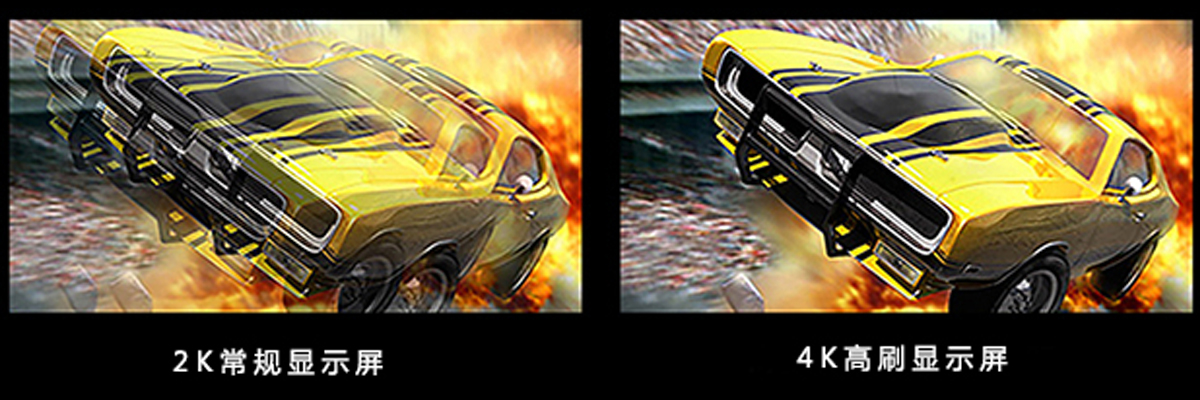
10. Full-color Display High Refresh Rate Defect:
In recent years, led display is widely used in a variety of large-scale sports events and international activities, coupled with a variety of camera equipment in the shutter and camera speed technology is changing rapidly, the general 240Hz refresh rate of the led scanning screen in the shooting will be scanning ripple and screen gray scale loss, resulting in poor camera quality, has been unable to meet the needs of the high-end market, therefore, the development of high refresh rate scanning screen technology gradually gain attention, the driver chip also responds to the high-end demand to launch scanning display solutions.
Refresh frequency refers to the number of times per second the led display information is displayed in full, the unit is Hz. refresh frequency is too low, the human eye to watch the led display will have the phenomenon of jitter, through the camera will have scan lines appear. General human eye refresh frequency requirements for more than 300Hz, that is, if the refresh rate of more than 300Hz, the average person with the naked eye to watch the led display will not have the feeling of jitter, and if you use the camera to shoot according to the different settings of different cameras, generally Z less require more than 600Hz to capture the scan line.
High refresh can improve the brightness of the display and color fidelity effect. With a digital camera can be detected, if it is a high refresh, the picture taken by the camera is very clear, no snow spots and scan lines. This indicator is especially important when leasing screens and TV transmissions.
The visual refresh frequency is above 3,000Hz for high performance high brush led display. The higher the visual refresh rate, the more stable the screen display, the less visual flicker. The low refresh rate not only affects the camera, photography, horizontal stripes, but also will occur like tens of thousands of light bulbs at the same time flickering image, the human eye in the viewing may produce discomfort, and even cause damage to the eyes.
Indoor full-color display with high refresh drive, can make the led display smooth and flicker-free playback screen, the clearer and more eye-catching images, the more vivid and colorful.
11. Effects of Low Refresh Rate:
• 1). It will cause black scan lines on the screen when recorded through cameras.
• 2). The images will look like tearing and trailing off.
• 3). It will show small mosaics or small blocks in different colors.
But all these effects will be observed when you are viewing it through a camera because anything faster than 15fps will go unnoticed by the human eye.
12. How to Change Refresh Rate on Monitor?
There are the following ways to change display refresh rate:
• 1). Use better hardware, Drive IC, adopt a high refresh rate model.
• 2). Change the scan model, use more IC drivers, PCB design, increase the processing ability to buffer data.
• 3). Use good software like Brompton or Nova star. It will help a lot with the refresh rate.
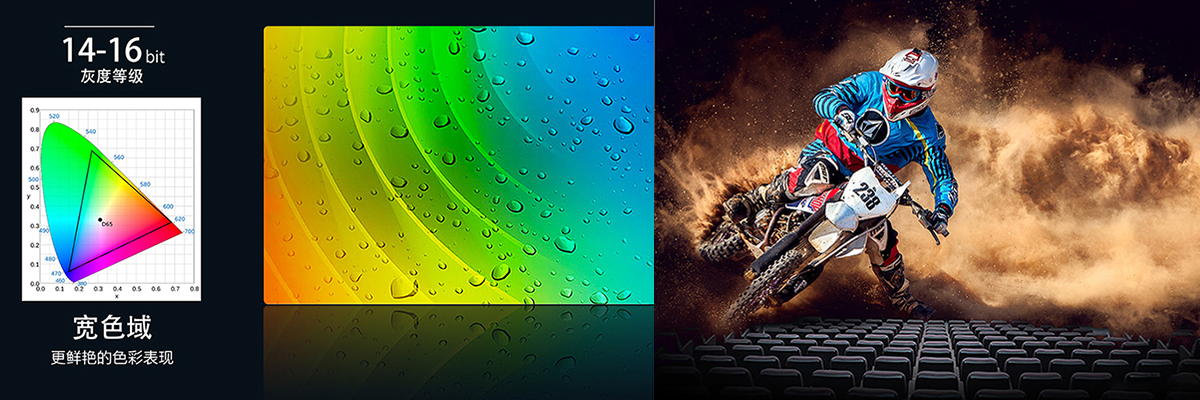
13. Variable Refresh Rate (VRR):
The frames time of a source is not always the same, especially when we talk about games. It can drop, and when that happens, it will lead to screen tearing because the refresh rate of the screen and frame rate of the game will not match. To overcome this problem, there is a feature called Variable Refresh Rate (VRR). The purpose of this feature is to check the frame rate and refresh rate on the go. When the frame rate of the game falls, the screen’s refresh rate will decrease automatically, but this is suitable only when the screen and source both can support VRR.
High-performing monitors with better refresh rates have apparent visual effects, but their benefits are observed on broader terms. These screens have built-in technologies to reduce eye strain. Samsung leds have increasingly introduced wide-curved screen monitors. This means that the viewing distance from left and right of the screen will be the same as it is in the middle to have less stress on eyesight.
The Samsung leds with a high refresh rate come with premium features like complete support USB type-C connections. This will decrease the number of cables at your workstation and will negate other costly docking stations.
14. The Cause of Water Ripples When the LED Display Is Photographed:
Water is the source of all things, water ripple graphic form of beauty and cultural beauty fusion, to the modern design is still optimally integrated, water ripple in our lives pervasive, but also silently on the creep of everyone’s led display.
But the water ripples on the led display, but did not get everyone’s favorite, and can even be said to be disgusted. Especially in some meetings, studios, live events, and other occasions that use a lot of photography and video, live led screen covered with water ripples so that the original activity through the dissemination of pictures, video, become flawed.
The reason for the proliferation of water ripples is the use of led display refresh rate is insufficient, the moment of photo imaging on some led display line is not lit, it produces a series of water ripples phenomenon. To 1/4 sweep, equipped with ordinary crossflow driver IC, refresh rate of 1000Hz screen as an example, set the camera exposure time of 1/1000 seconds, 1/500 seconds, 1/800 seconds, 1/2000 seconds, the following conditions will occur.
• 1). Only at a shutter speed of 1/500 seconds, all lines are lit 2 times, the brightness is consistent shot effect.
• 2). And 1/800 seconds and 1/1000 seconds shutter speed, there are some rows are lit more than 1 time, producing different degrees of water ripples.
• 3). At the shutter speed of 1/2000 sec, half of the rows are not lit, so you can imagine the number of water ripples.
• 4). Only the refresh frequency is greater than 2 times the camera shutter speed shooting, led display will not appear water ripples.
In the camera generally 1/2000 seconds shutter speed, the ordinary crossflow driver IC nearly 1000 refresh rate and dual-lock driver IC 1920Hz refresh rate, are not enough to circumvent the water ripple. Only with more than 3840Hz refresh rate of high-definition high-grade PWM driver IC, better protection of led display photography without water ripple.
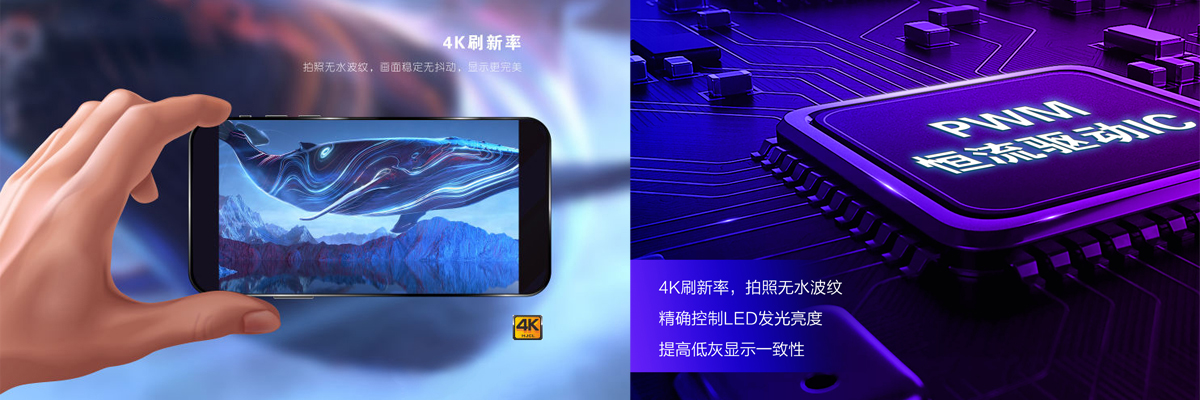
15. How to Solve the Water Ripple?
According to the led refresh rate to classification, there are two kinds of common led display on the market, one is the conventional model 2K refresh rate led display, one is 4K high refresh rate led display, screen sister found that the improvement of consumer display needs and the support of technical development, more and more customers choose high refresh rate display.
- 1). More Comfortable for Human Eye Perception
LED display refresh rate refers to the screen update rate, to put it bluntly, the number of times the lamp beads flash in a second.
The higher the refresh rate, the lower the flicker, the better the stability of the screen, on the contrary, the lower the refresh rate, the worse the stability of the screen, the more easily the human eye feels fatigue. When the update rate is greater than 1000Hz, the human eye is not distinguishable, so the market appeared 1920Hz conventional refresh rate (i.e., 2K refresh rate) of the led display.
- 2). Electronic Identification Without Ripple
With the development of live broadcast, naked eye 3D, AR, and other industries as well as related activities broadcast, photography retention on the display needs to improve, 4K high refresh rate led display application rate significantly increased.
In addition to solving the problem of human eye perception, 4K high led screen refresh rate can also solve the display in cell phones, cameras, video recorders and other optical electronic devices under the lens of the screen shaking problem, beyond the machine equipment recognition range of ultra-high update rate, so that it presents a more stable picture, optical lens photography without water ripples.
- 3). Quality Chip Better Performance
LED display refresh rate is controlled by the chip, the better the overall performance of the chip, the higher the control precision of the lamp beads, the more realistic color response, the cost is relatively higher.
- 4). PWM Constant Current Driver IC
To let users, have a better display experience, our indoor full-color D-P2.0 upgrades the whole system with high performance and high brush PWM constant current driver IC to adjust the output level current size, precisely control the led luminous brightness and improve the consistency of low gray display.
- 5). Dual 4K Extreme Display
LED display is stitched together by a single lamp bead, there is no physical, optical stitching, the screen without a sense of fragmentation, with the development of led display small pitch, able to present 4K screen through point-to-point resolution, 4K refresh rate combined with 4K image quality to bring the ultimate display effect of high brush HD, will again impact the existing market.
16. Summary:
So, in the end, I would say that while arranging a professional event, if you want to have a good quality image from your screen, always use a screen that is in synchronization with the camera recording frequencies because, in this way, the painting will look clear and perfect. It is recommended to use a screen with a refresh rate of 1000 Hz or above to appear clear and smooth in images.
About LEDSINO
As a professional LED Display Manufacturer, LEDSINO provides reliable products, comprehensive services and creative solutions.Since establishment, our team has been continuously innovating. Our Rental LED Display,LED Poster, Stage LED Screen, Flexible LED Display,Transparent LED Display, Church LED Wall, Concert LED Screen, LED Drape Screen, Nationstar LED Screen, LED Display Ball, Stadium LED Screens have the most advanced technology and forward-looking design in the present market.
For more information about LEDSINO, please follow us on Youtube, Twitter, Facebook, Instagram or Linkedin!
Related Products Or Cases


